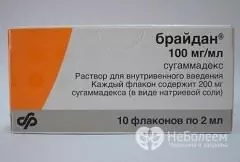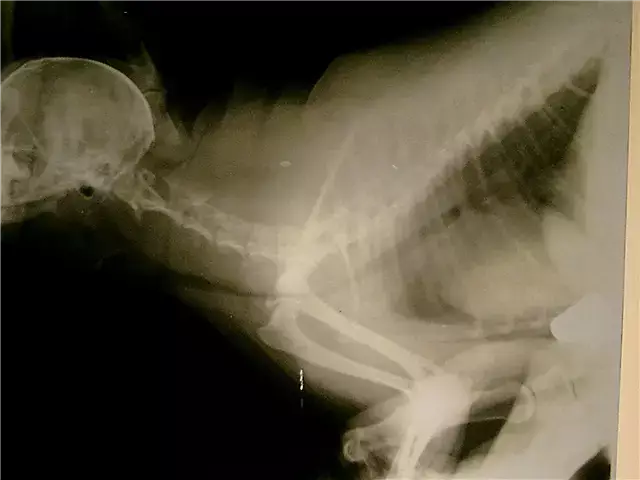- Author Rachel Wainwright [email protected].
- Public 2023-12-15 07:39.
- Last modified 2025-11-02 20:14.
Brydan
Instructions for use:
- 1. Release form and composition
- 2. Indications for use
- 3. Contraindications
- 4. Method of application and dosage
- 5. Side effects
- 6. Special instructions
- 7. Drug interactions
- 8. Terms and conditions of storage

Brydan is a selective antidote to muscle relaxant drugs.
Release form and composition
Brydan is available in the form of a solution for intravenous administration: transparent, colorless or light yellow (2 ml and 5 ml each in colorless glass vials, 10 vials in a cardboard box).
Composition for 1 ml of solution:
- active substance: sugammadex (in the form of sodium sugammadex) - 100 mg;
- auxiliary components: water for injection, sodium hydroxide or hydrochloric acid (to obtain a pH of 7.5).
Indications for use
Brydan is used in adult patients to relieve neuromuscular blockade of various depths caused by vecuronium bromide or rocuronium bromide.
In children over 2 years of age and adolescents, the drug is used in standard clinical situations to eliminate neuromuscular blockade caused by rocuronium bromide.
Contraindications
- severe renal failure (creatinine clearance less than 30 ml / min);
- children under 2 years of age;
- period of pregnancy;
- lactation period;
- hypersensitivity to sugammadex.
Caution should be exercised when using the drug in patients with severely impaired liver function.
Method of administration and dosage
The drug Brydan is injected intravenously into the system for intravenous administration or as a single injection for 10 seconds directly into a vein. The introduction of the drug should be carried out only by an anesthesiologist or under his direct supervision.
Brydan can be administered in one system for intravenous administration with the following solutions: 5% dextrose solution, 0.9% sodium chloride solution, Ringer's solution, 0.45% sodium chloride solution with 2.5% dextrose solution, 5% dextrose solution at 0, 9% sodium chloride solution, Ringer's solution with lactic acid. When using sugammadex in children, the drug can be diluted with 0.9% sodium chloride solution to obtain a solution concentration of 10 mg / ml.
If, before the introduction of Brydan, drugs incompatible with Sugammadex were introduced into the infusion system, or drugs whose compatibility with Brydan has not been established, it is necessary to thoroughly flush the system, for example, with isotonic sodium chloride solution.
The recommended dose of the drug depends on the degree of neuromuscular blockade and does not depend on the type of anesthesia.
For adult patients, to eliminate neuromuscular blockade in standard clinical situations, a dose of 2 mg / kg or 4 mg / kg is required (depending on the degree of restoration of neuromuscular conduction after blockade). For emergency restoration of neuromuscular conductivity in case of blockade caused by rocuronium bromide, the drug is administered at a dose of 16 mg / kg.
Re-introduction of Brydan during recurarization in the postoperative period is recommended in exceptional cases. The dose of the drug in this case is 4 mg / kg. Neuromuscular conduction should be monitored until neuromuscular function is fully restored.
Data on the use of the drug Bridan in children over 2 years of age and adolescents are limited. The recommended dose for the elimination of neuromuscular blockade in standard clinical situations is 2 mg / kg. The drug should not be used for the emergency restoration of neuromuscular conduction, since there is insufficient experience in the clinical use of Sugammadex in emergency situations in children over 2 years of age and adolescents.
In renal and / or hepatic insufficiency of mild and moderate severity, as well as in elderly patients, dose adjustment is not required.
In overweight people, the dose of the drug is calculated based on the actual body weight, that is, according to the recommendations proposed for patients over 18 years of age.
Side effects
Most often, during the use of the drug Bridan, complications of anesthesia were observed, for example, the appearance of coughing or physical activity during the period of anesthesia or the surgery itself. In this case, additional administration of anesthetics and / or opioids may be required.
In rare cases, an unintentional restoration of consciousness was noted during the process of anesthesia, however, the relationship of this effect with the administration of sugammadex has not been established and is unlikely.
Hypersensitivity reactions were rarely observed, which ranged from isolated skin effects (urticaria, redness, erythematous rash) to serious systemic, including anaphylactic, reactions (tachycardia, a sharp decrease in blood pressure, laryngeal and tongue edema).
When the drug is administered to patients with a history of indications of complications from the lungs, bronchospasm may develop.
special instructions
Artificial ventilation of the lungs must be carried out until the patient's spontaneous breathing is fully restored. In case of repeated neuromuscular blockade that develops after extubation, the necessary ventilation of the lungs should be provided in a timely manner.
Renewal of neuromuscular blockade was most often observed with the introduction of insufficient doses of the drug, which were lower than recommended.
The interval between the administration of Brydan and the repeated administration of rocuronium bromide at a dose of 1.2 mg / kg should be at least 5 minutes, between the administration of sugammadex and the repeated administration of rocuronium bromide at a dose of 0.6 mg / kg or vecuronium bromide at a dose of 0.1 mg / kg - at least 4 hours.
With the urgent elimination of neuromuscular blockade, re-administration of muscle relaxants can be carried out no earlier than 24 hours later. If an earlier recovery of neuromuscular blockade is required, non-steroidal muscle relaxants should be used.
The use of the drug Brydan in patients who received vecuronium bromide or rocuronium bromide in the conditions of the intensive care unit has not been studied.
Sugammadex should not be used to eliminate neuromuscular blockade caused by suxamethonium or benzylisoquinoline compounds, as well as other steroid muscle relaxants.
Slow recovery of neuromuscular conduction can be observed in elderly patients, patients with renal and / or hepatic insufficiency, and those with diseases of the cardiovascular system.
In patients with coagulopathies during the period of application of the drug Brydan, it is necessary to monitor the coagulation parameters, since sugammadex can increase the bleeding time.
The diluted solution is physically and chemically stable for 48 hours at a temperature of + 2 … +25 ° C (subject to aseptic rules). Under aseptic conditions, the storage time of the solution should not exceed 24 hours at a temperature of + 2 … +8 ° C.
During the use of the drug Bridan, it is necessary to avoid driving a car and performing other potentially hazardous activities associated with a high concentration of attention and the speed of psychomotor reactions.
Drug interactions
With simultaneous use with hormonal contraceptives, it is possible to reduce their plasma concentrations, and, consequently, their effectiveness.
Fusidic acid, flucloxacillin and toremifene can renew neuromuscular blockade by displacing vecuronium bromide and rocuronium bromide from the complex with sugammadex.
Brydan is physically incompatible with ranitidine, verapamil and ondansetron.
Terms and conditions of storage
Store in a dark place at a temperature of + 2 … +8 ° C, do not freeze. Keep out of the reach of children. The shelf life of the solution is 3 years.
Information about the drug is generalized, provided for informational purposes only and does not replace the official instructions. Self-medication is hazardous to health!






